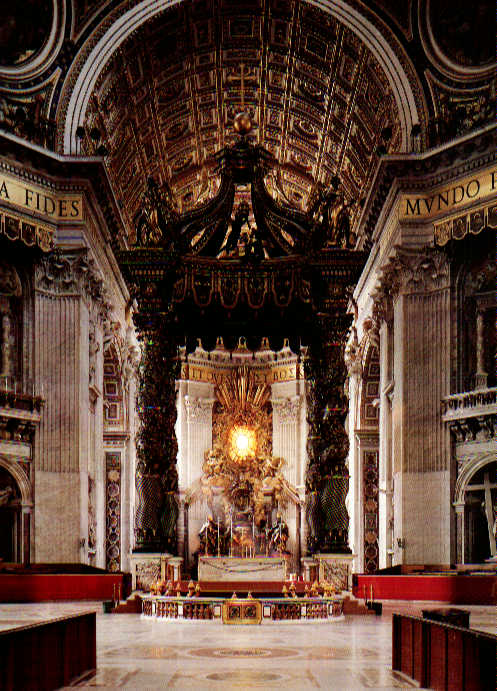|
|
 |
|
2 Settembre-St. Peter's |
|
written
by Angela Hitt / 07.12.2004 |
|
|
| |
Itinerary |
| |
We began our day by walking down the Via Guilia toward the Vatican. After making it through initial security guards enforcing the strict dress code (no shorts, short skirts, or bare shoulders), we entered St. Peter's Basilica and were struck by its scale and opulence. It was more ornately decorated than any of the other churches we’ve visited but the sheer size of the building made appear more grand than gaudy. To the right stood Michelangelo's Pieta (1499), separated from the viewers by glass. Bernini's baldacchino (made of bronze taken from the ceiling of the Pantheon), stands above the high altar. The Chair of St. Peter, also by Bernini, lies further behind the high altar. Stephanie was “expecting more pews within the basilica.” To her it seemed “very much set up for tourists.”
Our next stop was the Necropolis of St. Peter's (64 AD). From Shawn’s previous experience we were expecting an American priest as our tour guide. Several students were prepared with general questions about the Roman Catholic Church as well as the other churches we’d seen, but left with questions unanswered because our tour guide was clearly not a priest or nun.
The tour began in a room with models of the original monument to St. Peter’s grave, located in a pagan cemetery, and the original St. Peter’s Basilica built by Roman emperor Constantine between 324 and 349. The walls are decorated with old sarcophagi and tomb slabs. In search of St. Peter’s relics, secret excavation of the tombs under St. Peter’s began in 1940. In 1950, Pope Pius XII announced that the remains of St. Peter were officially “discovered” deep below the high altar. Upon further investigation, it turned out the bones of several people, though the archeologists were sure this was the original tomb of St. Peter. In 1969 it was announced that the real relics were found behind a graftti-covered slab near the original tomb. Today, St. Peter’s bones have been returned to the place they were discovered in protective containers. The slab and the top of one of the boxes are visible from the last stop of the tour.
Many well-preserved pagan mausoleums were also found in the necropolis, though many were altered during the building of the original basilica. Beautiful mosaics, statues of gods, and frescos decorate the houses of the dead. Some are purely pagan while others document the transition of individual families to Christianity. One particular mosaic portrays Christ as Helios, the sun god. Other walls in the same mausoleum also depict Jonah and scenes of fisherman.
Recent renovation provides better access, lighting, and climate control to preserve the graves. Futuristic automatic glass doors control access between different areas. At one point we were rushed past a beautiful mosaic floor because the group only had 30 seconds to get through the next door. Overall, our tour seemed rushed and our guide seemed annoyed with our questions. Paul M. called St. Peter’s size “overwhelming” and the pope’s tombs “kind of creepy.” He also really enjoyed the tour of the necropolis.
On the way back to the Campo there are many gift shops providing a wide variety of very tacky souvenirs. There were giant three-dimensional holograms of a giant Pope waving and smiling over a miniature St. Peters and another with Mary/Jesus images that depended on the approach angle. Other shot glasses diplomatically labeled “Roma” with only a St. Peter’s dome, pope bottle openers, and cheep rosaries.
|
| |
|
| |
|
| |
Highlights |
| |
Michaelangelo’s Pieta was a definite highlight, although it would have been even better if we had been able to get closer too it and walk around it. It’s hard to really appreciate sculpture without a full 360 degree view. The necropolis tour was also informative and interesting but it would have been better had our tour guide been more tolerant of questions.
|
| |
|
| |
|
| |
Images |
| |
| |

|
|
| Bernini's Baldacchino |
|
| |
|
| |

|
|
| Christus helios |
| Christus helios, the mosaic of Sol in Mausoleum M, which is interpreted as Christ-Sol |
| |
|
| |

|
|
| St Peter's Basilica |
| View from about the middle of the Piazza San Pietro |
| |
|
The first image, Bernini's Baldacchino, provides perspective of the scale of the building and the ornate nature of the decoration. Its really hard to grasp the scale without actually being in the basilica, although taking more of the ceiling into the frame of the picture would probably give even better perspective. The lack of tourists also makes the scale seem smaller because it is hard to relate the scale to the height of an average person. This particular picture also makes the basilica look darker. In real life (maybe it was the time of day we visited) it was brighter and more golden toned.
Christus Helios is the mosaic discussed in the itinerary section. This particular picture doesn’t show the entire image; about half is cut off in this particular picture.
The last photograph provides perspective on the scale of the building on the outside. It only shows some of the columns and doesn’t do justice to the circular design.
|
| |
|
| |
|
|
 |
|
